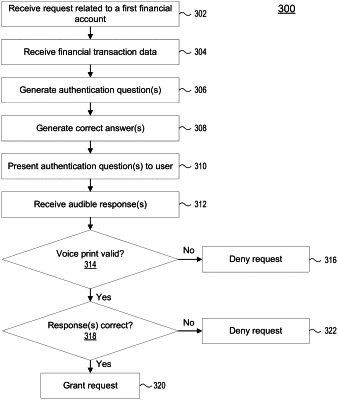| CPC G06Q 20/4014 (2013.01) [G06F 21/32 (2013.01); G06Q 20/4016 (2013.01); G10L 17/24 (2013.01)] | 20 Claims |

|
1. A method comprising:
receiving, by a computing device, a request for authorization to perform an action relating to a financial account;
generating, by the computing device and based on financial transaction data relating to the financial account, a set of authorization questions required to be answered correctly to grant the request for authorization to perform the action relating to the financial account;
providing, by the computing device, a first authorization question of the set of authorization questions to a user;
receiving, by the computing device, from the user, and via a listening device, an audible response to the first authorization question;
determining, by the computing device, a voice print of the user based on the audible response to the first authorization question;
training, based on a plurality of voice samples collected from the user during a corresponding plurality of prior authentication processes, a machine learning model to identify a voice of the user;
comparing, by the computing device, the voice print of the user to an expected voice print of the user, wherein the expected voice print of the user is generated by the computing device based on the plurality of voice samples collected from the user during the corresponding plurality of prior authentication processes;
determining, by the computing device, based on the trained machine learning model, and based on comparing the voice print of the user to the expected voice print of the user, a confidence score indicating a likelihood that the user is an authorized user of the financial account;
modifying, by the computing device and based on comparing the confidence score to a predetermined threshold, a size of the set of authorization questions required to be answered correctly to grant the request for authorization to perform the action relating to the financial account
comparing the audible response to the first authorization question to a first correct answer of a set of correct answers to the set of authorization questions; and
granting the request for authorization based on the audible response to the first authorization question matching the first correct answer and based on the voice print of the user matching the expected voice print of the user.
|